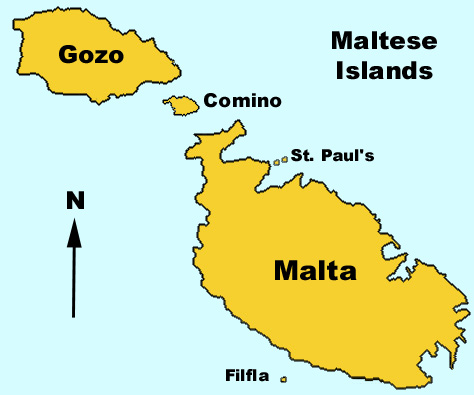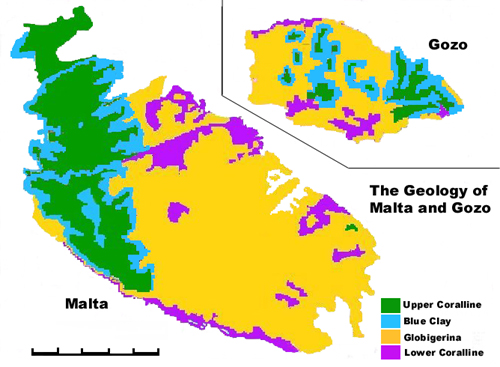Natural History of the
Maltese Islands
![]() [Geography][Geology][Flora][Fauna]
[Geography][Geology][Flora][Fauna]![]()
 The Maltese Islands consist
of the islands of Malta, Gozo and Comino, together with a few
smaller islets such as Filfla, St. Paul's Islands and Cominotto.
The Maltese Islands consist
of the islands of Malta, Gozo and Comino, together with a few
smaller islets such as Filfla, St. Paul's Islands and Cominotto.

The islands lie in the centre of the Mediterranean at latitude 360 and longitude 14.300 and are 96 km (58 miles) south of the Ragusa penisula of Sicily. The Tunision coast is 320 km (180 miles) to the west of the islands with Tripoli lying 350 km (220 miles) to the south-south-west.
The Maltese archipelago trends north-west by south-east. Malta has a length of 27 km (17 miles by 9 miles wide) while Gozo is 14.5 km (9 miles by 4 miles wide) long.
Malta has an area of 245.7 km2, that of Gozo is 67.1 km2 while Comino is about 2.5 km2. The total area of the archipelago is about 316 km2 . Malta has a shoreline of 136.8 km and an altitude of 253 m, while Gozo, with an altitude of 191 m, has a shoeline of 42.6 km. The Malta-Gozo Channel is 4 km wide.
The islands have a population of 379 000 with a population density of 1183 per km squared. The harbour area and the south-east have densities higher than the average.
The climate of Malta and Gozo is typically Mediterranean with hot dry summers, warm showery autumns and short cool winters with insufficient rainfalls in most years. Temperatures range between 90C to 300C with an average rainfall of 530 mm.
The Maltese soils are highly calcareous with a pH exceeding 8.0. Three main types are recognised. The carbonate raw soils, of recent origin, are very low in organic content and can have up to 90% calcium carbonate when derived from the soft limestone. Xerorendzina soils are more mature with up to 6% organic content and 50-80% calcium carbonate presenting a surface which is pale brown in colour. The terra soils (terra fusca, terra rosa and intermediates) are of ancient origin with a high organic content (4.5%) and a low carbonate content (2-15%) to to prolonged leaching. Disturbed soil occurs all over the islands.
The islands are composed entirely of Tertiary limestones with some clays and patches of surface Pleistocene deposits. The whole sedimentary sequence is dominated by marine carbonates deposited in shallow waters. The carbonates aer not unlike those of the Ragusa region of Sicily and those of the Sirte Basin in Libya. The rock formation is as follows:
| MIOCENE | Tortonian | Upper Coralline Limestone | > 162 m |
| Grensand | 0 - 11 m | ||
| Serravillian | Blue Clay | 0 - 65 m | |
| Langhian | Upper Globigerina Limestone | 5 - 20 m | |
| Burdigalian | Middle Globigerina Limestone | 0 - 110 m | |
| Lower Globigerina Limestone | 5 - 110 m | ||
| OLIGOCENE | Chattian | Lower Coralline Limestone | > 100m |
The oldest formation is the Lower Coralline Limestone outcroping in the coastal sections mainly towards the western sides of the islands where it forms vertical cliffs. Inland it is associated with dry valley - wied - sections or faulted inliers. The base of the formation is massive and consists of yellow biomicrites rich in benthonic foraminifera. This underlies a pale-grey bedded coralline algal limestone structure rich in fossil corals and the molluscs Lithophaga, Cardita, Natica, and Strombus. The uppermost section is a coarse bioclastic limestone exhibiting extensive cross-bedding and rich in the fossil echinoid Scutella subrotunda.
The Globigerina Limestone formation is a pale-yellow rock composed almost entirely of planktonic foraminifera. The formation is sub-divided into three sections separated by two phosphorite conglomerate horizons. The middle section of the limestone has a pale-grey colour. The formation provides the Maltese building stone or 'Franka'.
The lowest subdivision is a massive bedded, globigerinid biomicrites which weathers with characteristic honeycomb features. The mollusc fossils include Chlamys and Flabellipecten. The pteropod Cavolina is abundant as is the echinoid Schizaster parkinsoni. The middle section is a pale-grey marly biomicrite with a fauna similar to the lowest division. Thalassinoidean burrow systems are prominently developed. The upper subdivision is similar to the top in structure but fossils are few except for some pectinid valves, the gastropod Epitonium and the pteropod Vaginella.
The Blue Clay overlies the Globigerina formation and consists of an aternation of pale-grey and dark-grey banding depending on the contained carbonate which in any case is never more than 30%. Fossils are common though macrofauna specimens are usually crushed and disarticulated. In the upper region, goethite impregnated specimens of the molluscs Aturia aturi, Sepia, Flabellipecten and Chlamys are common. Deposition is believed to have occured in an open muddy marine environment at depths of up to 150 m.
The Greensand is a poorly cemented bioclastic, glauconitic limestone. It is a greyish rock when fresh due to abundant black and dark-green grains of the mineral glauconite. When exposed it has an orange brown colour due to chemical changes in the mineral. The formation consists largely of transported material and is rich in fossils of marine mammals, echinoids and molluscs such as Conus, Chlamys, Ostrea, Glycimeris Thracaea and Cardium. The foraminifer Heterostegina is also very common. Deposition took place under shallow water marine conditions.
The youngest formation in the Maltese Islands is the Upper Coralline Limestone which in many respects is similar to the oldest formation. Three major subdivisions have been recognised, the lowest composed of thinly bedded alternations of the coralline Lithothamnium bands and yellowish marly bands and abundant fossils. The lower division is soft pure limestone used locally for the maufacture of lime., The upper subdivision is composed of massive compact beds.

The Maltese Islands tilt NE giving a coastline of submergence with deep bays including the Grand Harbour which has been described as the finest in the Mediterranean. The SW side is bounded by sheer vertical cliffs where the entire geological formation can be seen.
The surface topography is determined by the underlying formation. The Upper Coralline limestome produces flat-topped plateaus, clays form 45o slopes. The Globigerina, outcropping over two-thirds of the islands, produces a rolling countryside and the Lower Coralline sheer, vertical cliffs.
A large number of faults occur predominantly ENE-WSW. These produce a horst and graben system at the north of the island. One major fault lies along the WNW-ESE.
The first references to the study of the flora of the Maltese Islands dates back to the ancient Roman writers Diodorus Siculus, Cicero and Lucretius who wrote about the cultivation of cotton on the islands and Quintinus who mentions the olive, vine and fig trees amongst other trees grown in Malta. The first scientific attempt at a list of the flora of Malta was by Dr. strefano Zerafa, during the period 1827 - 1831, who enumerated about 600 species, 500 of which were recognised as native to the islands. In 1853, Dr. Grech Delicata published his Flora Melitensis containing 716 species native to Malta and Gozo. More recently, in 1915, Dr. Stefano Sommier and Dr. A. Caruana Gatto, published their Flora Melitensis Nova which included 902 species of Phanerogams and 1085 Cryptogams. Descriptive Flora of the Maltese Islands was published by J. Borg in 1927 has for long been considered the standard work. The most recent complete work covering the flora of the islands is A Flora of the Maltese Islands, by Dr. S.M. Haslam et al, published in 1977. This short account is indebted to this workand publications by Edwin Lanfranco.
About 87% of the species of the flora inhabit inland areas and 14% inhabit coastal areas with a few common to both. 24% of the flora occur as weeds of cultivation and 16% as weeds in waste land. 66% of the species are Mediterranean.
The natural vegetation of the Maltese Islands is dominated by the
Mediterranean sclerophyllous scrub communities mostly types of
garigues typical of rocky ground and by numerous geophytes and
therophytes. Cliff side communities are dominated by shrubs and
are important because of a large number of endemic species such
as Palaeocyanus crassifolius and Cremnophyton
lanfrancoi of the family Chenopodiaceae.
Watercourses are few on the islands and are dominated by Areundo donax, Cyperus longus, Holoschoeneus vulgaris and Typha domingensis amongst others. A few retain water all year round and support species such as Populus alba, Salix pedicellata and Ulmus canescens.
The important endemic species of plants include Cremnophyton lanfrancoi, Palaeocynus crassifolius, Darniella melitensis, Chiliadenus bocconei, Hyoseris frutescens, Allium lojaconoi, Limonium melitense, L. zeraphae, Anacamptis urvilleana and Anthemis urvilleana.
Comments about this page to: [email protected]
This site last modified 30-November-2003
[Home Page][E-mail][Marine List][Terrestrial List][Bibliography][Endemics]